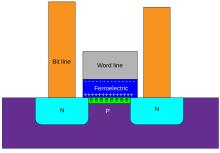Fe FET
| Computer memory and Computer data storage types |
|---|
| Volatile |
| Non-volatile |
A ferroelectric field-effect transistor (Fe FET) is a type of
FeFET based devices are used in FeFET memory - a type of single transistor non-volatile memory.
Description
In 1955,
FeFET based memory devices are read using voltages below the coercive voltage for the ferroelectric.[4]
Issues involved in realising a practical FeFET memory device include (as of 2006) : choice of a high permitivity, highly insulating layer between ferroelectric and gate; issues with high remanent polarisation of ferroelectrics; limited retention time (c. a few days, cf required 10 years).[5]
Provided the ferroelectric layer can be scaled accordingly FeFET based memory devices are expected to scale (shrink) as well as MOSFET devices; however a limit of ~20 nm laterally may exist[6] (the superparaelectric limit, aka ferroelectric limit). Other challenges to feature shrinks include : reduced film thickness causing additional (undesired) polarisation effects; charge injection; and leakage currents.[5]
Research and development

In 2017 FeFET based
As of 2017[update] the startup Ferroelectric Memory Company is attempting to develop FeFET memory into a commercial device, based on hafnium dioxide. The company's technology is claimed to scale to modern
See also
- Ferroelectric RAM, RAM that uses a ferroelectric material in the capacitor of a conventional DRAM structure
References
- ISBN 9783739248943.
- ^ Park et al. 2016, §1.1.1, p.3.
- ^ a b c Park et al. 2016, §1.1.1, p.4.
- ^ Park et al. 2016, § 1.1.2, p.6.
- ^ a b c Zschech, Ehrenfried; Whelan, Caroline; Mikolajick, Thomas, eds. (2005), Materials for Information Technology: Devices, Interconnects and Packaging, Springer, pp. 157 –
- ISSN 0003-6951.
- ^ S2CID 19624615
- ^ Lapedus, Mark (16 Feb 2017), "What Are FeFETs?", semiengineering.com
- Park, Byung-Eun; Ishiwara, Hiroshi; Okuyama, Masanori; Sakai, Shigeki; Yoon, Sung-Min, eds. (2016), "Ferroelectric-Gate Field Effect Transistor Memories: Device Physics and Applications", Topics in Applied Physics, no. 131, Springer
Further reading
- Ishiwara, Hiroshi (2012), "FeFET and ferroelectric random access memories", Multifunctional Oxide Heterostructures, pp. 340–363, ISBN 978-0-19-958412-3
